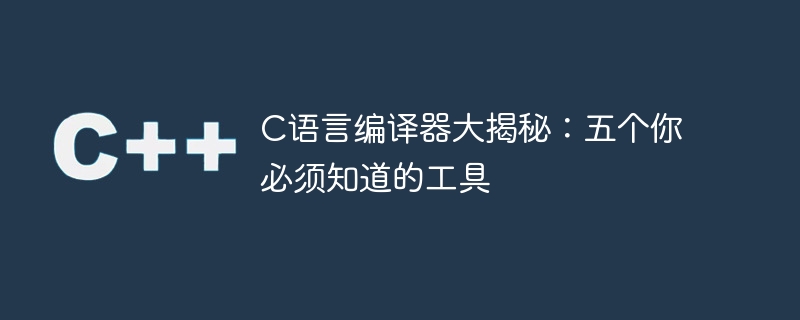Home >Backend Development >C++ >Revealing the secrets of the C language compiler: five essential tools
Revealing the secrets of the C language compiler: five essential tools
- 王林Original
- 2024-02-18 20:40:061351browse

The secret of the C language compiler: five tools you must know
Introduction:
In the process of learning and using the C language, the compiler Undoubtedly a vital tool. It can convert the high-level language codes we write into machine language so that the computer can understand and run our programs. However, most people still know very little about how compilers work and internal mechanisms. This article will reveal five must-know tools of the C compiler and use specific code examples to deepen understanding.
1. Preprocessor:
The preprocessor is the first stage of the compiler. Its main task is to perform some text replacement and macro expansion operations. It will process the code according to the preprocessing instructions we use in the code and generate preprocessed code. Common preprocessing directives include #include, #define, #ifdef, etc.
The following is a simple code example showing how to use the "#define" directive to define a constant:
#include <stdio.h>
#define PI 3.14159
int main() {
double radius = 5.0;
double area = PI * radius * radius;
printf("The area of the circle is: %f
", area);
return 0;
}In this example, the preprocessor will replace "PI" with "3.14159" before compiling again.
2. Compiler:
The compiler is the core tool in the C language. It performs syntax analysis and lexical analysis on the code generated by the preprocessor, and converts it into intermediate code. The working process of a compiler usually includes the following steps:
- Lexical analysis: Decompose the source code into individual lexical units (tokens), such as identifiers, keywords, operators, etc.
- Syntactic analysis: Organize lexical units into a syntax tree and check whether the syntax of the code is correct.
- Semantic analysis: Perform type checking and semantic analysis on the syntax tree to ensure the correctness of the code.
- Intermediate code generation: Generate intermediate code based on the syntax tree, which can be low-level assembly language, bytecode or other forms of intermediate representation.
- Optimization: Optimize the intermediate code to improve the performance and efficiency of the code.
- Code generation: Convert the optimized intermediate code into target code, which can be machine language or assembly language of the target machine.
3. Assembler:
The assembler is a tool that converts the assembly code generated by the compiler into machine language. It converts instructions (mnemonics) in assembly code into corresponding binary instructions in machine language and generates executable files.
The following is a simple assembly code example that implements the function of adding all elements in an array and printing it out:
section .data
array db 1, 2, 3, 4, 5
array_length equ $-array
section .text
global _start
_start:
mov ecx, array_length
xor eax, eax
xor ebx, ebx
lea esi, [array]
add_loop:
add al, byte [esi]
inc esi
loop add_loop
push eax
push format
call printf
add esp, 8
mov eax, 1
xor ebx, ebx
int 0x80
section .data
format db "Sum: %d", 10, 0In this example, the assembler will convert the assembly code into machine language and generate an executable file.
4. Linker:
The linker links multiple object files and library files to generate the final executable file. It is responsible for parsing symbol references (Symbol Reference) and relocation (Relocation), matching the symbols of functions and variables referenced in the program with their definitions, calculating relative addresses, and generating executable files.
For example, if we call a function in a third-party library in the source code, the linker will find the definition of the function in the library file and then match it with the call site.
5. Debugger:
The debugger is a tool for debugging programs. It allows us to execute the code line by line and view the values of variables, the status of memory, etc. Debuggers can help us locate and solve errors and problems in our programs.
Common debuggers include GDB, LLDB, etc., which provide a series of commands and functions, such as setting breakpoints, single-step execution, viewing register status, memory monitoring, etc.
Conclusion:
By understanding and understanding these five C language compiler tools, we can better understand the compilation and execution process of C language. Mastering these tools can not only help us write more efficient and reliable code, but also better understand and solve problems. Continuously learning and exploring the internal mechanisms of the compiler will help us become better programmers.
References:
[1] Advanced Compilation Techniques. Retrieved from: https://courses.cs.washington.edu/courses/cse501/04au/compilation.pdf
The above is the detailed content of Revealing the secrets of the C language compiler: five essential tools. For more information, please follow other related articles on the PHP Chinese website!

